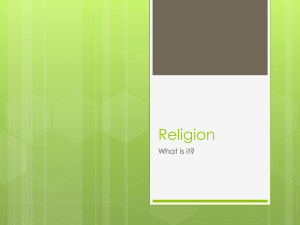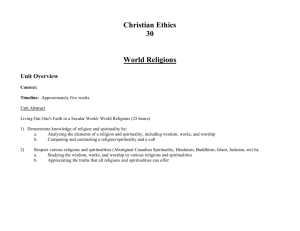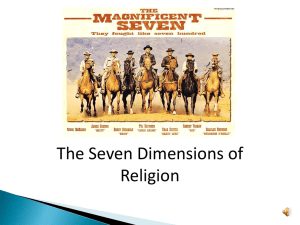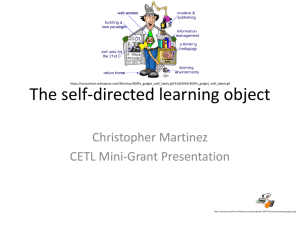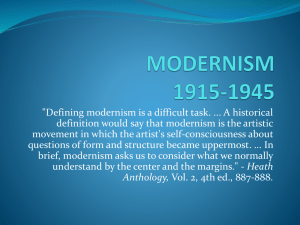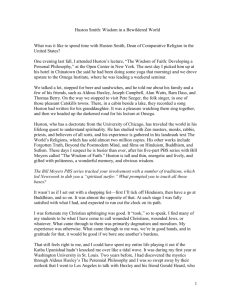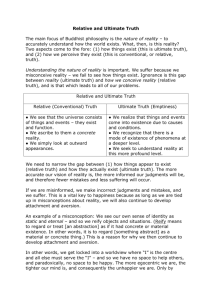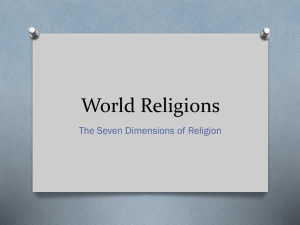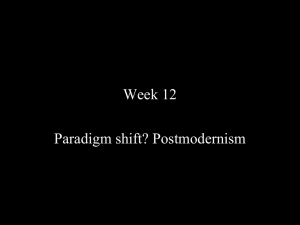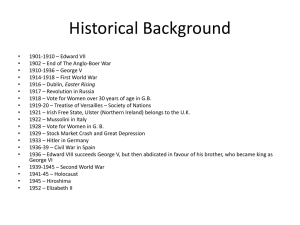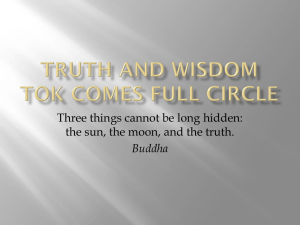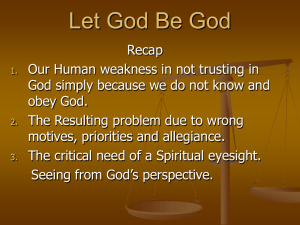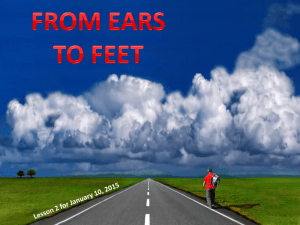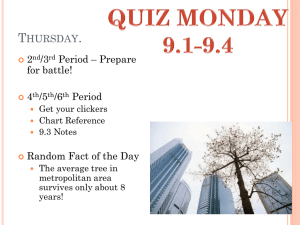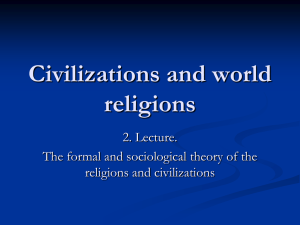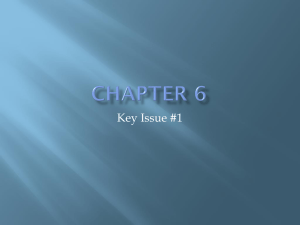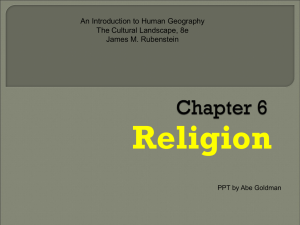Powerpoint - John Provost
advertisement
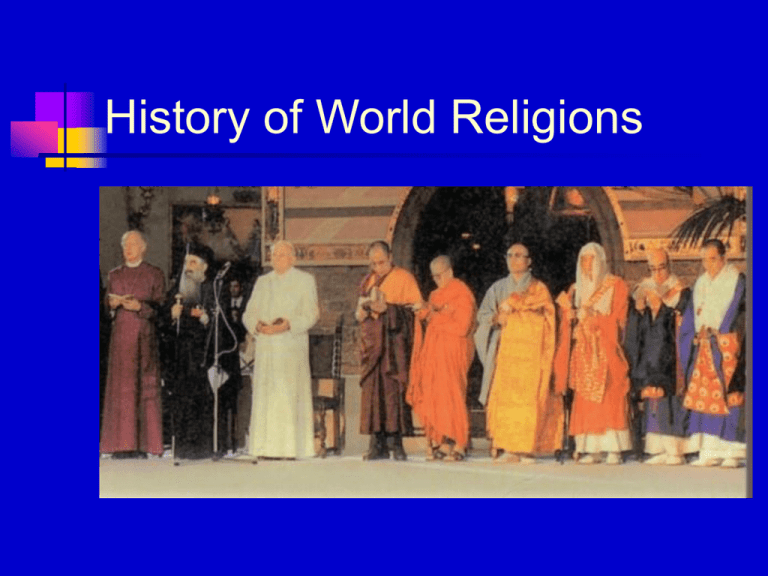
History of World Religions Wisdom Philosophy literally means “the love of wisdom.” Perspective Religion can be seen as a multiple layered series of teachings and practices that can be seen in a number of different ways. Integral Approach A key component of this course is the developmental and evolutionary model of religion as the guiding principle. A Developmental Model A developmental model of religion means that religion means different things to people who are at different levels of development. Three Basic Levels Three basic levels we will work with are the pre-rational, rational, and transrational levels. Trans-rational Development In order to develop to the trans-rational levels, people have to make a choice to do so. Emotional Responses A good thing to keep in mind in this class is to ask yourself what is going on if you are having an emotional response to a certain idea. Defining Religion “Traditional religion in innumerable different cultures affirms that human life has relationships and objectives beyond the ordinary, basic, physical and emotional needs of individual people…” A Sense of Wonder Abraham Joshua Heschel described religion as “a sense of wonder.” It is that sense of awe and radical amazement we can often feel at a display of nature, the birth of a child, etc. Religious Experience “Religious belief often springs from mystical experiencethe overwhelming awareness that one has been touched by a reality that far transcends ordinary life.” Why Study? “If there is to be peace among the nations, cultures, and religions of the world, religious differences must be known and respected. Conditioned Reality “To say something is conditioned simply means it is limited or restricted.” Unconditioned Reality “Its knowledge, wisdom, and mental power would be unlimited and would embrace all that could possibly be known or thought.” Unconditioned Reality Brahman (Hinduism) Nirvana (Buddhism) Toa (Taoism) Heaven (Confucianism) God (Judaism, Christianity, Islam) Animism (Shamanism) Conditioned Reality Maya (Hinduism) Samsara (Buddhism) Under Heaven (Taoism, Confucianism) Death (Judaism) The World (Christianity) Religious Expression “The first level of religious expression, the theoretical, embraces essentially the verbal expression: what is said.” Mythology Mythology is a story that reveals truth. In that sense religious myths can be very true in terms of the wisdom revealed while untrue in a literal sense. Practical Expression “The practices of religion constitute the form of religious expression referred to as the practical expression of religion: what is done.” Sociological Expression “Forms of organization, and the way they relate to the broader social context, are also part of religion, the sociological expression of religion.” The Descriptive Approach “It is not the purpose of a study such as this to decide on the ultimate truth or falsity of any religion. We are simply trying to know and understand them better.” The Critical Approach “Beneficial change will not occur unless questions are asked and criticisms made. But fair and effective change also requires the most accurate information and insight that can be garnered.” The Evolutionary Model All the founders of the world’s major religions came around the same time. Hunting and Gathering “Spiritual power was focused in the sky, the world of animals, and the ecstatic individual.” Agricultural Religion “The development of agriculture is generally viewed as a great landmark in religion, as it is in economic history.” Ancient Empires “Polytheism reached an apex during this period, for it was really a result of the union of a number of tribes into a single society.” Religion Response to History Epics gave a narrative story to a people that made sense of their history and usually showed that there was a higher purpose to where they were going as a society. Ritual “Another response is to keep certain rites … unchanged as a sort of a frozen perpetuation of the past before the discovery of history and as a symbolic area of experience untouched by it.” The Religious Founders “By making the life of a single individual the pivot of history, they acknowledge its irreversible movement and at the same time give it a sharply focused central axis.” Wisdom Wisdom is the part of religion that focuses not so much on theory or dogma, but on certain practices and disciplines which allow a person to undergo a transformation. Devotion Devotional sects placed more emphasis on their feelings than their intellect, love than on faith. Modernism “Modernism was a new exaltation of the secular world and the individual in it.” Liberalism “Liberalism in religion is essentially the restatement of religious absolutes so as to fit with the normative social and scientific values of the cultural context.” Current Problems Modernism created many problems such as the ecological crisis, nuclear war, materialism, and many modern medical problems caused by stress and addictions. Postmodernism Postmodernism can be summed up by the one word “skepticism.” Skepticism “Postmodernism is controversial because it challenges all of the assumptions of modernism, not least of which is that there can be certainty in religious faith.” Integral Philosophy Instead of saying something is stupid, it will instead ask, “What is right about it?” Women in Religion The role of women in religion needs special attention because it has been ignored in a significant way into recently. Context Remember that a trans-rational teaching can be limited by the prerational consciousness of the people following the leader. Shedding Light “Just to shed light on the subject is to call it into question.” Terminology “Approached by different ways of knowing, by different people, from different times and different cultures, the sacred has many faces.” Words…Ultimate Reality Immanent: Present in the world Transcendent: Existing above and outside of the material universe. Theistic: Religions based on one’s relationship to a divine Being. Monotheistic: When the Being is worshipped as a singular form Words…Ultimate Reality “If many attributes and forms of the Divine are emphasized, the religion may be labeled polytheistic. Religions that hold that beneath the multiplicity of apparent forms there is one underlying substance are called monistic.” Words…Ultimate Reality “Atheism is the non-belief in any deity.” “Agnosticism is not the denial of the divine but the feeling, “I don’t know whether it exists or not,” or the belief that if it exists it is impossible for humans to know it.” Words…Ultimate Reality Nontheism: “Ultimate reality may also be conceived in nontheistic terms. It may be experienced as a “changeless Unity,” as “Suchness,” or simply as “the Way.” There may be no sense of a personal Creator God in such understandings.” Mystical Insight “The only form of comprehension of God we can have is to realize how futile it is to try to comprehend him.” More Terminology “Myths are stories based on symbols.” “Cosmogony: Sacred accounts of the creation of the world.” “Eschatology: Beliefs concerning the purported end of the world.” More Terminology “Fundamentalism: The selective insistence on parts of a religious tradition and to violence against people of other religions.” More Terminology Liberalism: “Liberals take a more flexible approach to religious tradition.” Heretics: “Those who publicly assert controversial positions that are unacceptable to the orthodox establishment.” Mystics: “Those governed by their own spiritual experiences.” Perspective, Perspective It is true that religions have done, and continue to do, horrible things. But they have also done wonderful and glorious things.
